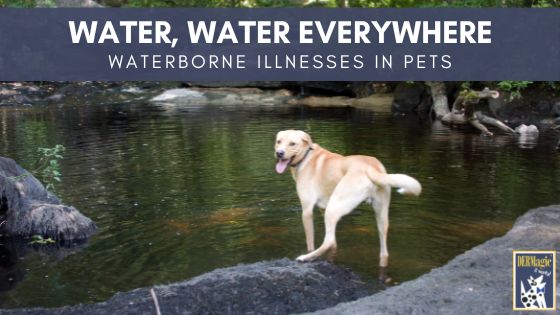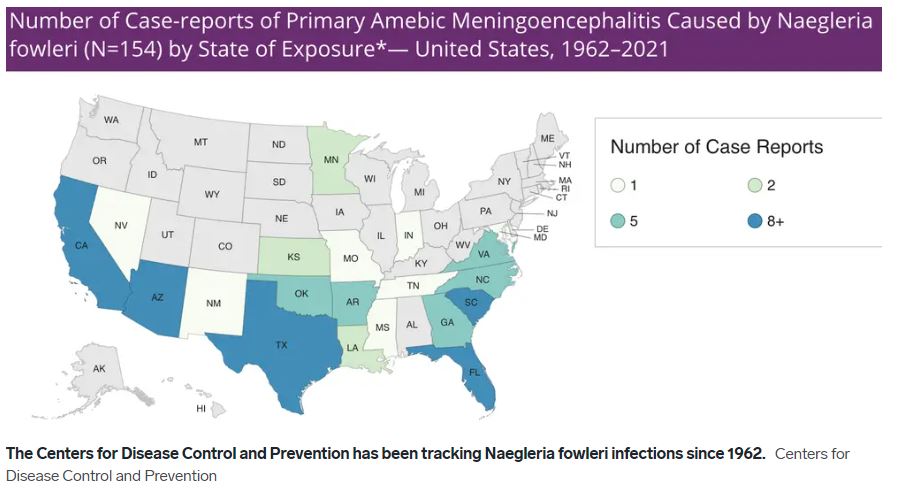
Everyone loves to jump into a lake or wade through a mountain river, but now that summer is here, we're seeing more illnesses related to water.
No matter where you live, waterborne diseases and illnesses are on the rise. So, before you head out for the weekend, be sure you’ve packed plenty of water and collapsible dishes for you and your dogs.
Most water-borne illnesses have been confined to specific areas of the country. However, as climate change ramps up and people continue to explore new areas, we’re seeing new bacteria in new regions.
Keeping Pets Safe in Water
We all know how difficult it is to keep pets out of water, and while it may mean they won’t have quite as much fun romping through rivers, it's the best way to protect them.
Be sure you also follow these guidelines:
- Research. Understand the risks of any specific area you plan to visit. This may include contacting your state or local forest department to learn of new risks.
- Vaccinate. If a vaccine is available, make sure your dog is up to date on them.
- Pay Attention: Make sure you read any signs posted around the water edge, and comply with directions. Don’t let your pets play in water that has an obvious smell to it, is contaminated with algae, or is standing water.
- Don’t be fooled. Even crystal clear water can contain parasites and microorganisms that can cause serious illness.
- Prompt Treatment. Be sure you obtain prompt care for you and your pets should you see any symptoms. Hygiene. Give your dog a bath prior to leaving the area. If you're unable to do so, be sure to bathe them upon arrival home. Pack it In,
- Pack It Out. Take your own water along on any hike and make sure your pets drink from that source. These are just a few of the waterborne illnesses you should watch for in pets.
This is a quick look at the more common waterborne illnesses we have found in the USA.

Harmful Algae Blooms (HABs)
Blue-green algae is one of the most common (and deadlier) bacterium that can show up anywhere in the United States. This bacteria (known as cyanobacteria) thrives in warm (over 75 °F), nutrient-rich water. When conditions are right, the bacteria can grow quickly forming “blooms”.
There is no way to tell if a blue-green algae is toxic by sight, so it’s best to avoid them completely.
These algae blooms may also contain:
-
Hepatotoxins: including Cylindrospermopsins, Microcystins, and Nodularins. Exposure occurs via ingestion with symptoms appearing in 1-2 hours. Symptoms may include acute depression, weakness and incoordination, loss of appetite, excessive drooling. vomiting and diarrhea, abdominal tenderness, jaundice, dark urine.
-
Neurotoxins: including Anatoxin-a, Anatoxin-a(s), and Saxitoxins. Exposure occurs via ingestion with symptoms appearing in minutes to hours. Symptoms may include excessive drooling, apprehension, anxiousness, vomiting, muscle twitching, seizures, or respiratory failure.
- Dermatotoxins: including Lyngbyatoxin-a and Aplysiatoxin. Exposure occurs via skin contact with symptoms appearing in minutes to hours. Symptoms may include rash, hives, or other signs of allergic reaction. Symptoms include vomiting, diarrhea, rashes, difficulty breathing, general weakness, liver failure and seizures.
Cyanotoxin (aka, "blue-green algae")
Officials at Zions National Park are warning visitors not to drink stream water anywhere in the park under any circumstances. There are no known recreational water filtration methods effective at removing cyanotoxins.
According to their official press release, “Toxin-producing cyanobacteria of the genera Microcoleus, Tychonema, and Nostoc have been found in the North Fork of the Virgin River, North Creek, and La Verkin Creek. Colonies of cyanobacteria can be yellow, tan, green, brown, or black in color. Toxins detected in Zion include anatoxin-a, nodularin, microcystin, and cylindrospermopsin.”
Symptoms can include, but are not limited to: skin rash, salivation, drowsiness, tingling, burning, numbness, pain, incoherent speech, seizures, vomiting, and diarrhea.
Cyanobacteria colonies grow on rocks, sticks and sand. Note the ribbed texture in the picture below.

Naegleria fowleri and Primary Amebic Meningoencephalitis (aka, "Brain eating amoeba")
Naegleria is an amoeba found in bodies of warm freshwater. Only one species of Naegleria infects people and pets, known as Naegleria fowleri. This amoeba causes a very rare but severe brain infection called Primary Amebic Meningoencephalitis (PAM), which is usually fatal.
While rare, this amoeba has traditionally been localized to the southern states. However, over the past few years, it has spread to other states including a recent case in Missouri, Florida, California, Texas, Kansas, Tennessee, Arizona, and others.

Cyanobacteria colonies like this will grow on rocks, sticks, and sand. Note the ribbed texture. (NPS)
Water Hemlock
Water Hemlock has recently been discovered around White Rock Lake, Texas. This dangerous water plant can be found anywhere in the United States, and is especially prevalent in the western half of the US.
Water Hemlock looks similar to yarrow, but is a dangerous weed that contains the chemical cicutoxin. Cicutoxin impacts the brain and central nervous system when ingested.
All parts of the plant are toxic, and just touching the plant can cause serious issues. Texas has decided to remove it by using an herbicide known as Rodeo (which contains the active ingredient glyphosate). While this herbicide is marked safe for aquatic environments, it’s not always safe for humans or pets. Be aware and exercise caution when visiting the Dallas/Ft. Worth region.

Leptospirosis
Leptospirosis is a bacterial disease that is spread through the urine of infected animals. The bacteria can be found in soil and water and can be carried and spread by a variety of animals (including rodents, wildlife, pets, and livestock).
Symptoms in dogs include fever, lethargy, lack of appetite, vomiting, diarrhea, and in severe cases may result in liver or kidney failure. Some dogs do not show signs of illness, and even after treatment, dogs with leptospirosis can shed the bacteria in their urine for several months.
In Arizona, leptospirosis in both dogs and people is rare and sporadic. However, this disease is on the rise, with several groups of leptospirosis positive dogs having been re Wear protective clothing and shoes to avoid exposure to contaminated water or soil.
Discuss vaccinating your dog against leptospirosis with your veterinarian
Giardiasis
Giardiasis is a small intestinal infection caused by a microscopic parasite that is widespread throughout the United States. This parasite spreads through contaminated food and water, and is most common in areas with poor sanitation. It can, however, live in any water source and survive without a host for weeks.
This parasite inhibits your dog’s ability to absorb nutrients, water and electrolytes.
Diarrhea is the most common symptom, although some dogs may experience weight loss, fatty stools, and abdominal pain.
This is a highly contagious disease and should be treated immediately. Dewormers or antibiotic therapy are used to treat symptomatic dogs. The long-term prognosis is very good when treated.
Pythiosis
(aka, Oomycosis, Lagenidiosis, Swamp Cancer, Bursatti, Leeches)
Pythiosis is a relatively rare infection caused by a type of fungus (Pythium insidiosum) that results in very serious and often fatal infections of the skin or intestinal tract.
This fungus prefers moist soil, and is most often seen in tropical and sub-tropical climates such as Southeast Asia, eastern coastal Australia, and South America the Gulf Coast states.
Symptoms include non-healing skin lesions, vomiting, diarrhea, and blood stools. The most obvious symptom is ulcerated, non-healing skin lesions. However, clinical signs also include fever, vomiting, weight loss, diarrhea and bloody stools.
While we often see hot spots in pets, Pythiosis is a "different animal" and results in massive skin lesions that are not responsive to traditional methods of treatment.
In most cases, surgery is required to remove lesions on the skin and in the bowel. Oral antifungal drugs can be attempted in cases where surgery is impossible, but rarely succeed in curing the fungal infection. The prognosis for complete recovery is poor.
Protothecosis
(aka, green algae or blue-green algae)
Protothecosis is a rare infection caused by achlorophyllic (no chlorophyll) algae in the Prototheca family. This algae is most often found in areas with decaying matter in water throughout the South and southeastern United States, northeastern Australia, southern continental Europe, and Japan.
Although many dogs come in contact with this organism, illnesses are rare and often associated with animals who have suppressed immune systems. The organism can cause skin lesions (similar to Pythiosis) as well as symptoms related to the central nervous system signs (such as seizures, blindness and incoordination).
If the large intestine is infected, you may also see diarrhea, vomiting and weight loss. Treatment consists of a surgical-medical approach using antifungal medications.
Stay safe around water this summer and be sure you keep pets safe as well.
Sources
- Harmful Algal Bloom-Related Illness Information for Veterinarians - Minnesota Dept. of Health https://www.health.state.mn.us/diseases/hab/vet/index.html
- Map shows where brain-eating amoebas are infecting people in lakes across the US https://www.insider.com/map-shows-where-brain-eating-amoebas-sickened-and-killed-swimmers-2022-7
- The Merck Veterinary Manual. “Overview of Algal Poisoning.” Last modified December 2013. Attention: Non-MDH link. Rankin KA, Alroy KA, Kudela RM, Oates SC, Murray MJ, Miller MA.
- Treatment of cyanobacterial (microcystin) toxicosis using oral cholestyramine: case report of a dog from Montana. Toxins (Basel). 2013;5(6):1051-1063. Hackett ES, Twedt DC, Gustafson DL.
- Milk thistle and its derivative compounds: a review of opportunities for treatment of liver disease. J Vet Intern Med. 2013;27(1):10-16. https://www.health.state.mn.us/diseases/hab/vet/index.html
- Toxic Bacteria Dangerous To Children & Dogs Detected In Zion National Park Waterways https://unofficialnetworks.com/2022/06/14/deadly-toxin-zion-national-park/
- Toxic Cyanobacteria Bloom in the Virgin River and the Streams of Zion National Park - Zion National Park (U.S. National Park Service)
- https://www.nps.gov/zion/planyourvisit/toxic-cyanobacteria-bloom-in-the-virgin-river-and-the-streams-of-zion-national-park.htm Water Hemlock. US Forest Service. https://www.fs.fed.us/wildflowers/plant-of-the-week/cicuta_maculata.shtml

